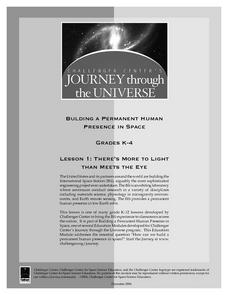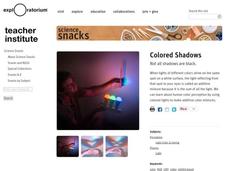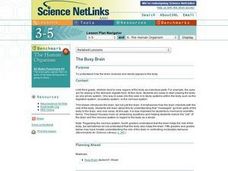Tinybop
The Human Body
Examine the systems of the human body with a bold, charming, and kid-friendly application. This noteworthy tool is certain to get kids interested what goes on inside of them! The eye feature uses the tablet camera to view images and show...
LABScI
Vision Lab: The Eye
Our bodies have some amazing capabilities, but there are some limitations. Explore the limitations of the human eye through the eighth lab activity in a series of 12 biology lessons. Individuals measure their own peripheral vision and...
101 Questions
Candle Eyes
Candlelight is in the eye of the distant beholder. Scholars first watch a video clip of a commercial claiming that the human eye can see candlelight from 10 miles away. They use this information to calculate how far we can see...
Curated OER
Vision and Optics: Light and Lenses
Young scholars gain a conceptual comprehension of the functioning of the Human Eye in relation to optics and optical vision correction. They explore optics with light sources and various lenses, relating these to visual acuity,...
Curated OER
What is the Anatomy of the Visual System?
Students research the structures and functions of the eye. In small groups they dissect a model of the human eye, identify structures of the eye, and describe the functions of the photoreceptors.
Curated OER
There's More to Light than Meets the Eye
Learners explore the concept that not all light is visible to the
human eye. Although UV light is not visible, it can still be harmful, causing sunburns or skin cancer. They use special beads to detect UV light around the school....
Curated OER
Colored Shadows
Students examine how humans perceive color. In this refracted light lesson, students explore the different ways color is seen by the human eye. Students will use colored lights and colored paper and solid objects to make additive color...
Curated OER
Adding Colors
Students investigate the combination of colors created by the human eye. The activity highlights the eye's ability to retain the individual colors and add them together to produce a third when the colors are spun.
Howard Hughes Medical Institute
What is My Carbon Footprint?
Here is a activity that walks youth through an online carbon footprint calculator produced by the University of California, Berkeley. Once learners finish inputting information, they compete a worksheet with the results. This is simple,...
Curated OER
Bug Eyes
Third graders observe, predict, record and report on a series of experiments with a praying mantid to test its visual acuity. They study the parts of an eye and compare human and mantid eyes.
Curated OER
X-Ray Eyes
Students observe Australian X-ray paintings for information and to understand the art techniques used. Then they imagine and draw the inner organs of an animal. Students also research the anatomy of the animal to analyze the accuracy of...
Museum of the American Revolution
Through Their Eyes: Major Causes and Events of the American Revolution
Looking for an efficient way to explore the causes and results of the American Revolution? The American Revolution Museum offers a seven-lesson series to hit the highlights of this turning point, using primary sources and activities such...
Curated OER
Teaching Awareness of Human Development
Students examine the process of human development and identify the reasons for a good nights sleep. Individually, they write a list of the situations in their lives which are stressful. As a class, they discuss myths about stress and...
Curated OER
Lights, Camera, Action!
Learners explore various images and recognize that in order to make a visible image using a camera or using our eye, light is required. In small groups, they observe how the eyes respond to changes in light and record their observations...
Curated OER
The Eye and Color Images
High schoolers study the eye. In this biology lesson plan, students observe and experiment with visual images as they learn about the basic parts of the eye. High schoolers also demonstrate how an image is projected upon the retinal...
Curated OER
The Learning Network: Poetry Pairing July, 21, 2011
Although not a complete lesson plan, this set of emotionally powerful texts could be used in a variety of lessons. From The New York Times' Learning Network site, the resource includes a poem, an excerpt from a New York Times article and...
Curated OER
Why Do People Fall in Love?
Students discuss human behavior, sexual selection and the underlying genetic and evolutionary reasons for mate selection. The, in groups, they rate the attractiveness of certain individuals and measure facial features for symmetry.
Curated OER
The Busy Brain
Students explore biology by completing a human body worksheet. In this human brain lesson, students identify the different anatomy within the brain and the functions those pieces form. Students read an article about signals in the brain...
Curated OER
Stanley Park and Aquarium Field Trip
Students explore the beauty of British Columbia by participating in a class field trip. In this ecosystem observation activity, students investigate the Vancouver Aquarium and Stanley Park, one of the largest parks in North America....
Curated OER
Dissection Scramble
Students discover the anatomy of a human body by dissecting a cow's eye. In this animal dissection lesson, students identify the structure of an eyeball by cutting open a cow eye and observing the insides. Students participate in an...
Curated OER
Variations on a Human Face Lab
Ninth graders gain an application level understanding of probability, symmetry, and ratios and rates that exists in one's everyday environment relative to human genetics.
Cornell University
Thinking with the Eyes
Objects are larger (or smaller) than they appear! Scholars use a laboratory investigation to explore the difference between resolution and magnification. The activity allows them to calculate the size of the field of view of their light...
Curated OER
Penny and Cup Game
Students study the human body and their five senses by participating in a penny cup game. In this human senses lesson, students test their monocular and binocular vision by completing a penny drop experiment.
Curated OER
Skin: Skin Prints
Students explore human anatomy by participating in a print experiment. In this human skin lesson, students define the term "epidermis" and utilize computer paper, pencils, tape and baby wipes to create a print of their own skin. Students...
Other popular searches
- The Human Eye
- Human Eye Powerpoint
- Drawing the Human Eye
- Human Eye Diagrams
- Parts of the Human Eye
- Label the Human Eye
- Biology Human Eye
- Human Eye Function
- Human Eye 5th Grade
- Human Eyesight
- Anatomy of the Human Eye
- Human Eye Reproducibles

























